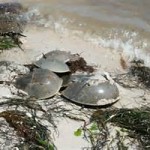
Growing up in the Pensacola area, I do not remember seeing many horseshoe crabs around here, but I do remember them. What I actually remember was how common they were further east in the Panama City and St. Joe area. These animals are big fans of grass beds, as are sea urchins and scallops, and all are uncommon in our area now. However, there have been local sightings in recent years, so they may be returning.
Horseshoe crabs are actually not crabs at all but members of a group of arthropods called chelicerates, which include spiders, mites, and scorpions. They differ from crabs in the absence of antenna, in which the crabs have two pairs. Their “horseshoe” shaped body is a body design to plow through the sand and mud searching for food. They are scavengers and feed on mollusk, worms, and other invertebrates – even algae at times. They do not have the large claws that blue crabs have, so they grab small bits of food where they can. Horseshoe crabs do possess a crop and gizzard and have tooth-like structures within the gizzard to grind their food. When digesting, the flesh is swallowed and the shell is regurgitated. The large spine near at the end of their bodies makes them appear similar to stingrays, which they are often confused, but the spine is actually a telson and non venomous. It is used to right itself when flipped and to push themselves in a forward direction.
They like shallow water and grassbeds are prime habitat for them. Breeding season is in the spring and early summer. During the full and new moons, both the large females and smaller males approach sandy beaches in protected areas of the bay. During the evening, they will begin to emerge into the intertidal zone where the female digs a depression and lays her eggs. The males, usually riding her back attached by a special hook, will then fertilized the eggs before they are buried. There may be more than one male trying to court the female (known as satellite males) and the numbers of horseshoe crabs on the beaches can be amazing.
Shorebirds, fish, and crabs will feed on the eggs and the young. Sea turtles are known to consume adults. Being members of the phylum Arthropoda, they will have to molt their exoskeletons as they grow. Many people will find these thin, tan-colored, molts along the shoreline.
There is a fishery for them in some parts of the southeast. They are collected for their blood, which is used in many medical processes needed for surgery and injections, and as bait for eels. The decline of these animals has been problematic for some species of migratory birds, who feed on their eggs during their migration. The horseshoe crab is also one of those rare animals that have been around longer than the dinosaurs. It would be sad to lose this animal on “our watch”. FWC is interested in where they are nesting. If you are out walking the beaches of the Florida Panhandle and encounter one of them, please contact the Sea Grant Agent at your county extension office; we are particularly interested in where they may be nesting. FWC has a website where sightings can be logged, http://www.myfwc.com/research/saltwater/crustaceans/horseshoe-crabs/documenting-beaches/.
The full and new moon cycles for spring and summer (2017) are:
Full Moon New Moon
Apr 10 Apr 26
May 10 May 25
Jun 9 Jun 23
Jul 8 Jul 23
They could nest a few days before or after. We hope you get to see one, they are pretty cool!
![]()
Posted: April 21, 2017
Category: Natural Resources, Wildlife
Tags: Ancient, Crabs, Horseshoe, Mariner…, Panhandle Outdoors


